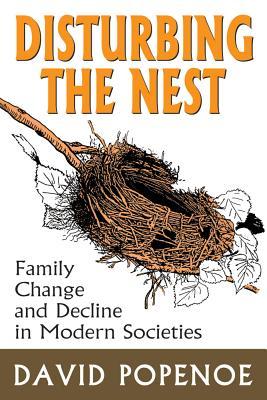Disturbing the Nest is among the finest and most readable works of comparative sociology published in the last ten years, and the most effective critique of the Swedish welfare state now in print. David Poponoe’s careful, fully documented, and gently devastating portrait of modern Sweden surprises the reader, in part, because Poponoe is himself a social democrat and an admirer of the dream that motivated the “middle way” visionaries of the 1930’s. He is also a prominent scholar, currently at Rutgers University, and author of the popular college text Sociology.
The book succeeds because Poponoe is an honest man. He readily acknowledges the biases found in his discipline, and labors to overcome them. He notes that most of his colleagues refuse to acknowledge the modern phenomenon of “family decline” because they actually favor the passing of paternal authority, and the victory of women’s liberation, economic egalitarianism, and sexual permissiveness: the very engines of decline. The discipline of sociology, he adds, “consists mainly of secularists. . . . It is no secret either that most sociologists today are politically leftwing on most social questions.”
Poponoe crafts a theory of “family decline” that rests on the historical movement of Western peoples from the “nuclear family-kinship system,” rooted in tradition, toward a “post nuclear-family system.” This new order is marked by the disappearance of the extended kin group; a vastly curtailed role for the nuclear family, with the job of childrearing assumed by the state; radical individualism; the disappearance of marriage as a legal and social form; and a sexual ethic resting on random liaisons.
The architects of Sweden’s welfare state, he argues, sought to rescue the family from the negative side of modernity by transferring to government much of the risk associated with children. Yet Poponoe’s analysis shows how the new system proceeded to disrupt the very bonds of mutual obligation it claimed to serve. The pursuit of gender equality as “family policy” cut the heart out of family life, as affirmative action programs and tax reform corrupted the economic gains enjoyed in marriage. Ironically, the Swedes thereby sacrificed the natural socialism found in the family (the one place where the socialist slogan, “from each according to his ability, to each according to his need” actually works) in favor of a feminist-guided individualism, a revolution now almost complete. Even consumption, Poponoe notes, has been individualized in Sweden: the man in a household keeps and spends his money, and the woman keeps and spends hers, with limited sharing of goods, while the children enjoy various state services and allowances for their support. Gone is the family as a meaningful institutional buffer between individual and state.
Family decline in Sweden spawned other results undreamed of by the social architects. Poponoe notes that few Swedes any longer care for each other, in sickness or in health. Some call their system a “client society,” where “citizens are for the most part clients of a large group of public employees who take care of them throughout their lives.” Voluntary service of any kind has almost vanished, leading Poponoe to conclude that “volunteerism and familism go together, the one being an extension of the unpaid and informal care giving that marks the other.”
Poponoe concludes that “the very existence of the welfare state compromises the institution of the family.” He then compares results in Sweden with family life in Switzerland, New Zealand, and the United States, and shows how different policy choices produced different results. The Swiss, for example, have few meddling bureaucrats, a strong commitment to local government, and greater attachment to patriarchy and traditional gender roles (when the Swedes sent their wives to work in the 1960’s to meet a labor shortage, the Swiss imported more “guest workers”). In New Zealand and the United States, a church-centered life and a turn to suburbs composed of single-family homes resulted, for a time, in strengthened traditionalism. Yet Poponoe concludes that these nations, too, are on the Swedish path, and that the “pathologies of modernization” will drive them to a similar fate.
With all that it does well, Disturbing the Nest has its flaws. One is the author’s vague determinism, the sense that the spread of the “post nuclear family system” is inevitable. He posits events that might turn the situation around (e.g., religious revival), but without much conviction. Running through the volume is the sense that modern peoples are flotsam, caught in historical currents beyond their control.
Poponoe also lets the architects of the Swedish system off too easily. He argues that “whatever has happened to the family as a result of welfare-state activities. . . seems largely an undesired and unintended consequence . . . and not an intended outcome.” In fact, from the early 1930’s on, key activist Alva Myrdal pressed consistently for a “family policy” that gave first priority to feminist leveling, then to the socialization of childrearing and the destruction of the home economy. While her husband, Gunnar, had some misgivings about what their generation had wrought, Alva always seemed pleased with modern, post-family Sweden.
Finally, Poponoe cannot shake free of a lingering attachment to statism, as when he writes that “the path to stronger families ironically may involve increasing rather than decreasing the intervention of the state.” This statement resembles the. “if we try harder, next time we’ll get it right” school of thought found, until recently, among the Marxists; it also runs against the analysis found on the book’s other 389 pages. But perhaps it serves as an intellectual fig leaf, the necessary cover for an honest scholar resident on one of those socialist (and hardly democratic) enclaves otherwise known as an American university.
[Disturbing the Nest: Family Change and Decline in Modern Societies, by David Poponoe (Hawthorne, NY: Aldine de Gruyter) 390 pp., $49.95 (hardcover), $24.95 (paper)]

Leave a Reply